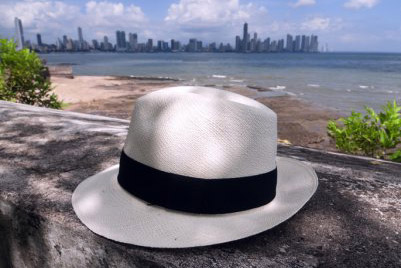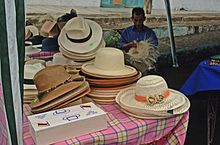A Panama hat, also known as an Ecuadorian hat or a toquilla straw hat, is a traditional brimmed straw hat of Ecuadorian origin. Traditionally, hats were made from the plaited leaves of the Carludovica palmata plant, known locally as the toquilla palm or jipijapa palm,[1] although it is a palm-like plant rather than a true palm.
Ecuadorian hats are light-colored, lightweight, and breathable, and often worn as accessories to summer-weight suits, such as those made of linen or silk. The tightness, the finesse of the weave, and the time spent in weaving a complete hat out of the toquilla straw characterize its quality. Beginning around the turn of the 20th century, these hats became popular as tropical and seaside accessories owing to their ease of wear and breathability.[2]
History
Beginning in the early to mid-1600s, hat weaving evolved as a cottage industry along the Ecuadorian coast as well as in small towns throughout the Andean mountain range. Hat weaving and wearing grew steadily in Ecuador through the 17th and 18th centuries.[4]
In 1835, Manuel Alfaro arrived in Montecristi to make his name and fortune in Panama hats. He set up a Panama hat business with his main objective being exportation. Cargo ships from Guayaquil and Manta were filled with his merchandise and headed to the Gulf of Panama. His business prospered as more and more Gold Rush prospectors arrived and passed through Panama needing a hat for the sun.[5]
One of the first towns to start weaving the hats in the Andes is Principal, part of the Chordeleg Canton in the Azuay province. Straw hats woven in Ecuador, like many other 19th and early 20th century South American goods, were shipped first to the Isthmus of Panama before sailing for their destinations in Asia, the rest of the Americas and Europe, subsequently acquiring a name that reflected their point of international sale—”panama hats”—rather than their place of domestic origin.
The term was being used by at least 1828.[6] The popularity of the hats increased in the mid-19th century when many miners of the California Gold Rush traveled to California via the Isthmus of Panama and Pacific Mail Steamship Company. In 1906[7], U.S. President Theodore Roosevelt visited the construction site of the Panama Canal and was photographed wearing a Panama hat, which further increased the hats’ popularity. Although the Panama hat continues to provide a livelihood for thousands of Ecuadorians, fewer than a dozen weavers capable of making the finest “Montecristi superfinos” remain. Production in Ecuador is dwindling, due to economic problems in Ecuador and competition from Chinese hat producers.
https://en.wikipedia.org/wiki/Panama_hat


